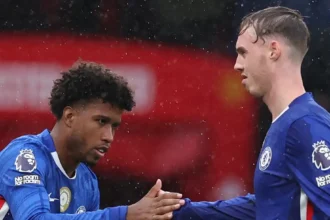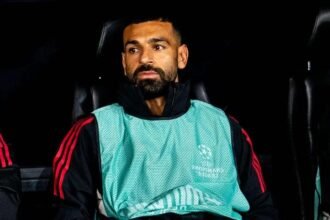Tottenham Hotspur’s £115 million double swoop for Mohammed Kudus and Morgan Gibbs-White has raised eyebrows. Both players are making significant moves down the Premier League ladder, joining Spurs in search of greater opportunities. But will they thrive in their new roles?
Spurs Make Bold Moves: The £115m Double Swoop That Defines Premier League Transfer History
Tottenham Hotspur’s summer transfer dealings have caused waves across the Premier League, especially after the £115 million arrival of two key players: Mohammed Kudus and Morgan Gibbs-White. These two signings are arguably among the most notable examples of players taking a significant step down in their career trajectories to join Spurs, raising questions about the evolving nature of Premier League moves.
Mohammed Kudus‘s move from West Ham United to Spurs is especially intriguing. A player who had an £80 million release clause just a year ago has found himself at the 17th-place club, Tottenham, in exchange for £55 million—a hefty £25 million less than his initial market value. Despite a promising spell at West Ham, where flashes of brilliance suggested the Ghanaian could be a star, his journey in East London failed to reach its full potential. With Spurs, however, Kudus seems keen to step up and prove himself, albeit for a club that finished in the lower half of the Premier League last season. In many ways, it reflects the instability and unpredictability that Tottenham has become synonymous with in recent years.
Morgan Gibbs-White, on the other hand, has made an even more drastic move down from Nottingham Forest to Tottenham. Despite an impressive season at Forest, Gibbs-White’s decision to join Spurs, who finished 17th, is puzzling to many in football circles. For a player who had established himself as one of Forest’s brightest stars, this decision could be seen as a gamble. His transfer fee has not yet been disclosed, but it is clear that Tottenham is betting big on him to help transform their midfield.
The Premier League is no stranger to high-profile transfers involving players moving to clubs lower in the table. However, what makes these two moves particularly noteworthy is not just the financials but also the trajectory of both players. The irony is that while Spurs have signed these promising players, the club remains in a position where they are not challenging for top-tier European football. If anything, their main ambition this season will be to stay clear of relegation.
In Premier League transfer history, we’ve seen similar examples of players making moves to clubs that have left fans and pundits scratching their heads. One of the most famous instances came in 2016, when N’Golo Kanté made the remarkable switch from Leicester City—fresh off their miraculous Premier League title win—to Chelsea, who were languishing in 10th place at the time. Chelsea, under new manager Antonio Conte, wasted no time in securing the services of the Frenchman, paying £32 million to Leicester in what became one of the most successful moves of the decade.
Similarly, Alex Iwobi made his controversial switch from Arsenal to Everton in 2019 for a hefty £34 million, despite the Toffees finishing significantly behind the Gunners. The move raised eyebrows, but Iwobi’s talent has continued to shine in a team that has struggled to meet its high expectations.
The Premier League has seen its fair share of “steps down,” with several players making unexpected moves to clubs in lower positions. Juan Mata, for instance, left Chelsea—then a top-three club—to join Manchester United in January 2014 for £37.1 million. United was in the midst of a crisis under David Moyes, sitting in seventh place, while Chelsea was still among the league’s top sides. The move seemed illogical at first, but Mata’s class continued to show despite United’s struggles.
Nemanja Matic’s £40 million switch from Chelsea to Manchester United in 2017 was another transfer that seemed out of place. United was in desperate need of stability after a failed season under Moyes, and Jose Mourinho targeted the Serbian midfielder to fill a key role. However, this deal, like others, seemed destined for mediocrity, as Chelsea used the funds to restock with younger talents, ultimately leading to United’s ongoing struggle to break into the top tier.
Then came Cole Palmer, who switched from Manchester City to Chelsea in 2023 for £42.5 million. At the time of his departure, City was still the Premier League’s top team, while Chelsea was struggling in the lower half of the table. Palmer’s move is one of the rare cases where a player has made the step down and performed admirably in a new environment.
Even Kyle Walker’s £50 million move from Tottenham to Manchester City in 2017 was seen as a step down at the time. City had finished eighth that season, and Walker had helped Spurs reach a comfortable second-place finish. But his decision to join Pep Guardiola’s City was vindicated as he helped City win multiple trophies, including the Premier League and Champions League, in subsequent years.
The most notable example, however, might be Moises Caicedo’s transfer from Brighton to Chelsea for a whopping £115 million in 2023. The move was especially striking given Chelsea’s struggles that season and Brighton’s rise in the Premier League. While many saw the deal as a statement of intent from Chelsea, it also underscored the confusing nature of Premier League transfers—where wealth and ambition sometimes overshadow current form.
As for Kudus and Gibbs-White, their decisions to step down from clubs in better form to join Tottenham Hotspur represent a curious new trend in football, where players are willing to accept lower positions if it means fulfilling their personal ambitions. Whether these moves prove successful remains to be seen. But one thing is certain: they will go down in history as some of the most notable “steps down” in the Premier League transfer market.











